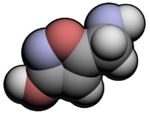
| |

| |

| |
| Names | |
|---|---|
| IUPAC name
5-(Aminomethyl)-1,2-oxazol-3(2H)-one
| |
| Other names
Agarin, Pantherine, Agarine, Pantherin
| |
| Identifiers | |
3D model (JSmol)
|
|
| 774694 | |
| ChEBI | |
| ChEMBL | |
| ChemSpider | |
| ECHA InfoCard | 100.018.574 |
| EC Number |
|
| KEGG | |
PubChem CID
|
|
| UNII | |
| UN number | 2811 3077 |
CompTox Dashboard (EPA)
|
|
| |
| |
| Properties[1] | |
| C4H6N2O2 | |
| Molar mass | 114.104 g·mol−1 |
| Melting point | 184 to 185 °C (363 to 365 °F; 457 to 458 K) |
| very soluble | |
| Solubility in ethanol | slightly soluble |
| Solubility in methanol | very soluble |
| Pharmacology | |
| Legal status |
|
| Hazards | |
| GHS labelling:[2] | |
| H300 | |
| P264, P270, P301+P316, P321, P330, P405, P501 | |
Except where otherwise noted, data are given for materials in their standard state (at 25 °C [77 °F], 100 kPa).
| |
Muscimol (also known as agarin or pantherine) is one of the principal psychoactive constituents of Amanita muscaria and related species of mushroom. Muscimol is a potent and selective orthosteric agonist for the GABAA receptor[3] and displays sedative-hypnotic, depressant and hallucinogenic psychoactivity. This colorless or white solid is classified as an isoxazole.
Muscimol went under clinical trial phase I for epilepsy, but the trial was discontinued.[4]
Muscimol, an agonist for the GABAA receptor, was able to significantly alleviate pain in its peak effect, recent studies from 2023 show. It has since been federally banned in Australia and is pending FDA review in the United States, but scientists believe it may relieve pain as well as some opioids without much of the risk of addiction associated with opioids. [5]
- ^ "Muscimol". The Merck Index Online.
- ^ "Muscimol". PubChem.
- ^ Johnston GA (October 2014). "Muscimol as an ionotropic GABA receptor agonist". Neurochemical Research. 39 (10): 1942–1947. doi:10.1007/s11064-014-1245-y. PMID 24473816. S2CID 13364321.
- ^ Heiss JD, Walbridge S, Rene'Smith RN, Sato S, Oldfield EH, Lonser RR (August 2012). "174 Convection-Enhanced Delivery of Muscimol to the Epileptic FocusPreclinical and Clinical Research". Neurosurgery. 71 (2): E568. doi:10.1227/01.neu.0000417764.02569.dc. ISSN 0148-396X.
- ^ Ramawad HA, Paridari P, Jabermoradi S, Gharin P, Toloui A, Safari S, Yousefifard M (2023). "Muscimol as a treatment for nerve injury-related neuropathic pain: A systematic review and meta-analysis of preclinical studies". The Korean Journal of Pain. 36 (4): 425–440. doi:10.3344/kjp.23161. PMC 10551397. PMID 37732408.